Golden Temple
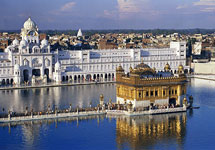
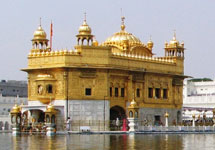
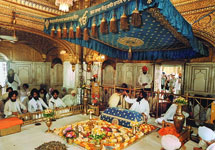
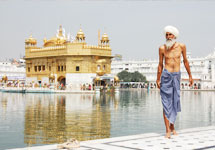
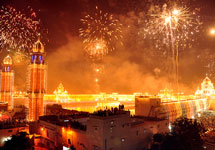
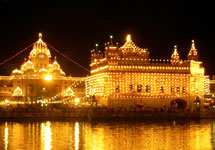
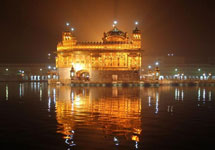

The Golden Temple, located in the city of Amritsar in the state of Punjab,is a place of great beauty and sublime peacefulness. Originally a small lake in the midst of a quiet forest, the site has been a meditation retreat for wandering mendicants and sages since deep antiquity. The Buddha is known to have spent time at this place in contemplation. Two thousand years after Buddha's time, another philosopher-saint came to live and meditate by the peaceful lake. This was Guru Nanak (1469-1539), the founder of the Sikh religion. After the passing away of Guru Nanak, his disciples continued to frequent the site; over the centuries it became the primary sacred shrine of the Sikhs. The lake was enlarged and structurally contained during the leadership of the fourth Sikh Guru (Ram Dass, 1574-1581), and during the leadership of the fifth Guru (Arjan, 1581-1606), the Hari Mandir, or Temple of God was built. From the early 1600s to the mid-1700s the sixth through tenth Sikh Gurus were constantly involved in defending both their religion and their temple against Moslem armies. On numerous occasions the temple was destroyed by the Moslems, and each time was rebuilt more beautifully by the Sikhs. From 1767 onwards, the Sikhs became strong enough militarily to repulse invaders. Peace returned to the Hari Mandir.
The temple's architecture draws on both Hindu and Moslem artistic styles yet represent a unique co evolution of the two. During the reign of Maharaja Ranjit Singh (1780-1839), Hari Mandir was richly ornamented with marble sculptures, golden gilding, and large quantities of precious stones. Within the sanctuary, on a jewel-studded platform, lies the Adi Grantha, the sacred scripture of the Sikhs. This scripture is a collection of devotional poems, prayers, and hymns composed by the ten Sikh gurus and various Moslem and Hindu saints. Beginning early in the morning and lasting until long past sunset, these hymns are chanted to the exquisite accompaniment of flutes, drums, and stringed instruments. Echoing across the serene lake, this enchantingly beautiful music induces a delicate yet powerful state of trance in the pilgrims strolling leisurely around the marble concourse encircling the pool and temple. An underground spring feeds the sacred lake, and throughout the day and night pilgrims immerse themselves in the water, a symbolic cleansing of the soul rather than an actual bathing of the body. Next to the temple complex are enormous pilgrims' dormitories and dining halls where all persons, irrespective of race, religion, or gender, are lodged and fed for free.
The Golden Temple Amritsar India (Sri Harimandir Sahib Amritsar) is not only a central religious place of the Sikhs, but also a symbol of human brotherhood and equality. Everybody, irrespective of cast, creed or race can seek spiritual solace and religious fulfillment without any hindrance. It also represents the distinct identity, glory and heritage of the Sikhs. To pen-down the philosophy, ideology, the inner and outer beauty, as well as the historical legacy of Sri Harimandir Sahib is a momentous task. It is a matter of experience rather than a of description.
Amritsar, the original name of first the ancient lake, then the temple complex, and still later the surrounding city, means "pool of ambrosial nectar." Looking deeply into the origins of this word amrit, we find that it indicates a drink of the gods, a rare and magical substance that catalyzes euphoric states of consciousness and spiritual enlightenment. With this word we have a very clear example of the spirit, power, or energetic character of a particular place becoming encoded as an ancient geographical place name. The myth is not just a fairy tale. It reveals itself as a coded metaphor if we have the knowledge to read the code: The waters of Amritsar flowing into the lake of the Hari Mandir were long ago - and remain today - a bringer of peacefulness.
What to See at Golden Temple
Hari Mandir (Divine Temple):
Which is the beautiful golden structure at the center of a large body of water. The gold-plated building features copper cupolas and white marble walls encrusted with precious stones arranged in decorative Islamic-style floral patterns. The structure is decorated inside and out with verses from the Granth Sahib (the Sikh holy book).
Amrit Sarovar (Pool of Nectar):
The water that surrounds the Hari Mandir is a sacred pool known as the Amrit Sarovar (Pool of Nectar). The temple is reached by following the Parikrama, which circumscribes the sacred pool in a clockwise direction. Connecting the pathway with the Hari Mandir is a marble causeway called the Guru's Bridge, which symbolizes the journey of the soul after death. The gateway to the bridge, the Darshani Deorhi, has magnificent silver doors.
Guru-ka-Langar, a Dining Hall:
Another major highlight of the Golden Temple complex is the Guru-ka-Langar, a dining hall where around 35,000 people a day are fed for free by temple volunteers. Everyone is invited to join this communal breaking of bread. All participants sit on the floor, regardless of caste, status, wealth or creed, powerfully symbolizing the central Sikh doctrine of the equality of all people.
Central Sikh Museum
In the Central Sikh Museum at the main entrance, galleries display images and remembrances of Sikh gurus, warriors, and saints; it includes some graphic portraits of the torture and execution of gurus.
Guest quarters
Guest quarters are also available for international Sikh visitors (for a nominal fee), and at least 400 simple rooms are provided (free of charge) to Sikh pilgrims.
Tourist Places in Punjab
About Punjab
Main Links
Travel Information
Exploring Punjab - Vacations
Punjab's Forestry and Wildlife
The Unique eco-system of the Shivaliks is spread over a geographical area 9448.97 Sq. km, and lies in the north-eatern part of the state extending from north-west to south-east along the Himachal Pradesh Border. It is spread across the eastern part of the districts of Gurdaspur, Hoshiarpur, Shaheed Bhagat Singh Nagar and Rupnagar


